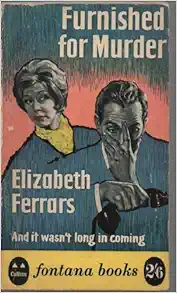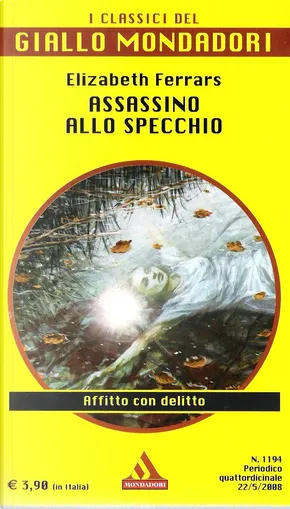Morna Doris MacTaggart (1907-1995), was born in Rangoon, Burma to a Scottish father and a German-Irish mother. After other books, she wrote her first mystery in 1940 with Give a Corpse a Bad Name, which was published, like all that followed, under the pseudonym Elizabeth Ferrars (using her mother's maiden name). She was married secondly to Robert Brown, a university professor of botany, in 1951 she followed her husband around the university, moving to New York, then London and finally Edinburgh. An extremely prolific author, Ferrars wrote 71 novels and remained in business until her death in 1995. In 1953 she was a founder of the Crime Writers' Association (which she chaired in 1977) and in 1958 she joined the Detection Club.
She published three series with a fixed character and many novels without:
Toby Dyke series (1940 to 1942: 5 novels)
Virginia and Felix Freer series (1978 to 1992: 8 novels)
Andrew Basnett series (1983 to 1995: 8 novels)
Without fixed character (from 1945 to 1995 : 53 novels)
In the flood of novels, Ferrars perhaps the only rival by number of Christie (she should have surpassed her by one novel), and underestimated for many years, is in constant revaluation: despite the enormous number and therefore understandably the presence of unsuccessful novels, compared to other of her colleagues (for Christie the reference is a must), a much more open attitude to the new, and towards certain "new" aspects: rock music, sex, the beat generation. Even her works, up to the end, maintain a good background, despite their age: something that does not happen in the case of Agatha Christie, whose works of the last few years show clear signs of fatigue and lack of lucidity. For Ferrars, the constant level of her works, even in her old age, was the result of a very rigorous way of life, on which even her origins, partly German, had evident influences. Her best works, according to many, are roughly those from the mid-1950s to the mid-1980s. Nonetheless, her first 5 novels, those by Toby Dyke, a contract journalist, & her friend George, an ex-criminal, are very good. She echoes, only in the unusual pairing, Chesterton's Father Brown & Flambeau. Toby is the classic amateur detective, of Van Dine's memory, but who is decisive for solving the cases is George: a kind of revenge of the proletariat (and of the "sidekick").
The novel, as one would expect from a British author, should have begun with an introduction, as usual in Christie's novels, in which the various characters are introduced, before the crime occurs: this practice, even if it is not present in all the Christian work, however, has a very marked evidence. Instead, in this novel by Ferrars, a novel which, as we have said, belongs to the 1950s, i.e. one of the most fruitful and inspiring periods, none of this happens. First of all, the crime takes place at least 100 pages from the beginning of the story, and in these 100 pages, the characters appear one after the other without a precise role; they are elusive characters, whose classification in the tragic plot is not well understood for a long time.
WARNING: SPOILERS !!!
Meg and Marcus are a couple who live in a house that is too big for them, as they are childless: he is a writer, but he doesn't earn much and therefore she rents an apartment in the cottage to a guy who arrives by Jaguar and whose name is Gerald Chilby . This fellow soon begins to ask strange questions about the Priory, a house that was originally a convent then destroyed during the Reformation, and about who lives there.
To inherit it should have been Kate Hawthorne, a young woman who had been adopted by Miss Velden, mistress of the Priory and other properties. Except that her old woman dying, she had changed the will and named her nephew Richard as her heir, excluding the young woman from her inheritance. The reason? The love between Kate and Roger Cronan. Roger was married to Daphne who had left him for someone, and so he had found love in Kate's arms. But then Daphne had returned, and realizing that her husband had decided to divorce her, he had threatened to kill himself. Roger had kept Daphne, and Kate had left. But her aunt had died before her, and the will had been changed. Now this Gerald Chilby goes around asking for information on the Priory: why? And these questions are certainly not without purpose, if it is true that he himself – before he is attributed a role in the story, when one thinks he is just a shady or in any case ambiguous type – insinuates that Miss Velden's death was not bronchitis as everyone accepted to have been and is surprised that there hasn't been an investigation: "..An old lady, a country doctor, and everyone is fully satisfied" (chapter 6, pages 66-67), when no one has yet thought of exhuming his body. Who is he, and why is he asking these questions?
Moreover, the story is already ambiguous in itself, it becomes more so when it becomes known that someone has spread that Richard Velden, that is the one who inherited the priory with the annexed properties, is an imposter. The fact is that Richard left when he was a boy, and came back already a man. But he proposes a settlement on the property to Kate who doesn't expect it, and he always answers interested questions with precise memories that intersect with those of Kate and which answer the truth. So is it him or isn't it him? Doubt creeps into the reader, and involves another of whom nothing is known, Chilby: isn't it him? Chilby shouldn't know Richard, but then, from conjectures made and which we see later answer the truth, he ascertains that it was a phone call from Chilby to Richard that caused the upheaval, a phone call that was intercepted by Daphne, that no one had invited to the Priory, but who had entered.
Why is Richard deathly pale? What does Chilby know that's so important?
It is following this phone call that the infernal machine moves: while Chilby is out of the house, someone enters it and steals something that is vital to him. Chilby thinks it was Kate, but it was Daphne instead. From the moment this stolen document reaches him, her life is worth nothing and she is killed. Shortly afterwards Chilby will also be killed, with his gun.
Daphne will be found by Richard in the water, and he will notify the police at the home of the widow Thea Arkwright, who is in love with her.
At this point the investigations are entrusted to Inspector Wylie who, with uncommon gifts of sagacity, manages to come out of the quagmire of things said and unsaid, and through increasingly daring hypotheses that affect all the characters in the drama, manages to give a sense of things and to frame a premeditated criminal plan, which had had the end of killing the old lady, and to answer some questions: why had Kate destroyed the will that named her heir, and which lay half-burned on the floor near the fireplace? Who had burned him if it hadn't been Miss Velden as had first been assumed? Who had advised the lawyer of the will to change the will, if the phone call had taken place when the lady had passed away? What was Chilby holding that had cost him and Daphne their lives? To whom was referred a note from Chilby about her appointment at 7.30 with a certain D.V. ? one could hypothesize that it was Richard Valden because (I had assumed it before it was mentioned) in English Dick is diminutive of Richard. But.. accused of the crimes, he knows how to get out thanks to unassailable alibis.
In a park of possible suspects ranging from Roger, the husband who no longer loved his wife, to Kate, the rival in love, to Marcus, who sometimes bordered on moments of madness, to Richard, whose role is not understood, important even if he was far away in all the crimes even of his aunt, to Thea who is in love with Richard and could have killed for him, but that when she arrived in the village, Richard had not yet returned from abroad and therefore did not know him , Wylie will nail the evil killer.
THE END OF SPOILERS
The novel is beautiful, it is fair to say. I would say a small masterpiece.
The descriptions of the characters are all-round, withering. And the relationships between them are not only hinted at, but explored in all their possible characteristics. Yes, it is a deductive novel, but it is above all from a psychological point of view: if until Daphne's death, the 100 pages are themselves an introduction, a very long introduction, from that moment on, everything changes perspective, and they are the same characters, as the story goes on, to define the framework of the situation: while in the classic investigation, the witness is reticent and the detective has to discover, through a whole series of questions, the truth, that it comes to the surface little by little, and it is the main actors of the drama, Roger and Kate and Miss Harbottle, the village spinster who knows everything, who dispel the veil at least in its most hidden truths, which do not frame the murderer, but at least help to make the picture more outlined: the old lady, despite being against the love between Roger and Kate, did not want to disinherit her; the new will did not exist nor had it ever been thought of; Kate had found the sheet of the will half burned and she had burned it completely herself, after the discovery of her aunt's body, because by attributing to her a desire to disinherit her that she had not had, for ethical correctness she had wanted to respect a will of her aunt, which however there hadn't been. So for that alone Richard had been involved while he was overseas. In short, a great mess!
Elizabeth Ferrars turns out to be a writer of race, very underrated, compared to many other authors of her time. Of course, as I said in the introduction, having written more than seventy novels, inevitably some novels may not have turned out well, but, if you have been churning out great novels for thirty years, there must have been some reason! This however is a little gem.
The reason lies, also and not only in itself, as in the basic idea of Ferrars which polarizes all the novels starting from the end of the 40s, that is when abandoning the series of Toby and Dyke, which is directly connected to the age of gold, of the amateur detective, Ferrars evolves the structure of the British detective novel, much more than Christie did: essentially, he sets his dramas in country houses, where the gentry does not act, as in Christie's typical novels (but also by Heyer), but normal people, as Curtis Evans says : “..regular people" (in practice this means white, college educated professional types)". Curtis adds: "One Fifties crime fiction critic referred to these books as "country cottage" mysteries, distinguishing them from the country house mysteries of the Golden Age. Here you tend not to have stuffy gentry and comic servants and great mansions and weekend house parties and stolen jewels and bodies bludgeoned in lib raries, but college-educated, middle-class commuter professionals, modernized cottages and bungalows, and grumbling women from the village who come in once week to clean”. Basically "The mysteries of the country houses" of which the critics of the 50s spoke, opposing them to those of the golden age (which are still present in Christie's 50s novels) in which the class of the ancient landed aristocracy acted, connected to military figures, to the curate of the village, to ladies of good society engaged in charitable actions, are those typical of Ferrars' novels in which a society operates which, if anything, is based on people with degrees, who make their way into society: the small bourgeoisie becoming average, compared to the old very conservative small landed aristocracy. It is essentially the middle class, the one already used by Ellery Queen. It's as if Ferrars, even using the typical means of British thriller (the murder in a country house or cottage, if you prefer, the return of the heir, the past abroad of some characters of whom little is known ) wanted to renew it by drawing on the great tradition of the Yankee.
Pietro De Palma



